NavSource Online: Submarine Photo Archive
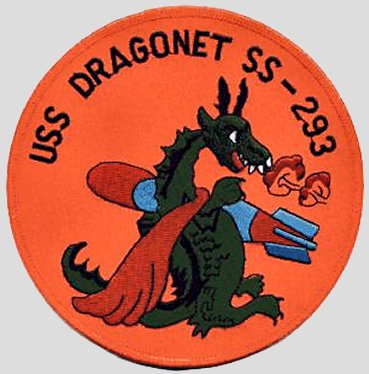
Contributed by Don McGrogan, BMCS, USN (ret.)
Please report any broken links or trouble you might come across to the Webmaster.
Please take a moment to let us know so that we can correct any problems and make your visit as enjoyable and as informative as possible.

| Click On Image For Full Size | Size | Image Description | Source | |
|---|---|---|---|---|
 | 672k | William Cramp & Sons Shipbuilding Company facilities, 15 March 1943. Cruisers visible in this photo: Far right - Miami (CL-89) - Furthest along; aft turrets and catapults in place.Left of Miami is Astoria (CL-90) - she is about a month behind Miami. Left of Astoria, in the large shipway, is Oklahoma City (CL-91) - a significant portion of hull has been built. Left of Oklahoma City is Little Rock (CL-92) - Keel was just been laid on 6 March, which is visible under crane structure. The coaling dock next to the cruisers site is known as grafitti pier" today. Note that there are also 2 ATF's: Seneca (ATF-91) and Nauset (ATF-89) fitting out on the right side near the graving dock being built which was never used when finished in 1945. It was fully functional, and used in the 50's when Keystone Ship Repair leased the property. Fast forward to 2014 when the last piece of the shipyard was demolished. The 'L' shaped building, across Girard Avenue which was the foundry & Machine Shop was the end. Note the 8 submarines in various stages of construction to the left of the Little Rock (4 per shipway). They are most likely from bottom right to left & bottom to top: The shipyard's submarine construction program was not especially successful. Poor management hindered the delivery of the boats. The first delivery was made two years after keel laying, and fitting out was then done by Portsmouth Navy Yard. The best construction time for a submarine was 644 days.
Cramp's submarine construction story was not a happy one for the Navy. Even though they got an early start on their Balaos, they had a lot of difficulty in hiring skilled workers and managers as most of the good ones already had jobs. Quality and timeliness suffered as a result. Cramp used the Government design plans, but used a completely different part numbering and inventory system, making coordination with Portsmouth, Boston, and Mare Island virtually impossible. The Government was forced to step in to straighten the mess out, with some of the boats ultimately being finished by other yards. |
Text courtesy of Tom Bateman, David Johnston (USN, retired) , Ron Reeves (of blessed memory), & Tracy White. USN photo # 80-G-38403 via Tom Bateman courtesy of Tracy White @Researcher @ Large. | |
 | 500k | Inverse of the above. | USN photo # 80-G-38404 via Tom Bateman courtesy of Tracy White @ Researcher @ Large. | |
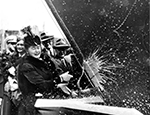 |
890k | Dragonet (SS-293) was sponsored by Mrs. J. E. Gingrich, wife of John E. Gingrich, then secretary of the General Board of the Navy before being assigned as naval aide to the inaugural Under Secretary of the Navy, James V. Forrestal. Gingrich served as Forrestal's aide from August 1940 to July 1944. He would go on to become 1st CO of the Pittsburg (CA-72), the first chief of security for the United States Atomic Energy Commission from 1947 to 1949, and as Chief of Naval Material from 1953 to 1954. His wife is pictured here doing the honors of christening the Dragonet on 18 April 1943. |
Text courtesy of wikipedia.org USN photograph courtesy of Dale Hargrave. |
|
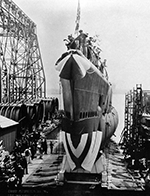 |
1.62k | Dragonet (SS-293) launched at Philadelphia, Pennsylvania, 18 April 1943. Photographed 4 April 1943. | USN photograph # 80-G-41837, now in the collections of the National Archives courtesy of the National Museum of the U.S. Navy, via flickr.com. | |
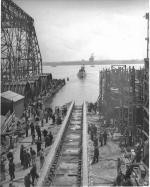 |
169k | This photo was sent sent to the Norford family with an attached date of 4/18/43. The photo was addressed to Mr. Norford, the father of Ron Norford, K.I.A., accompanied by a typewritten form from Press Association, Inc., 50 Rockefeller Plaza, New York 20, NY dated 11/15/46 with the notation, "Launching of the USS Escolar" (personal use). The charge was $1.25 with a note, "Please Remit" Part one of a twin launching. Dragonet (SS-293) & Escolar (SS-294) are launched on the same day: Unfortunately, who ever filed the photo was not discerning between the boats and this photo was misidentified as the Escolar leaving the ways. Among the more obvious discriminating factors between the pictures are: There amount of people in the same photo sequence just moments earlier, the launch ways are too clean between the skids, the amounts of small boats in the background and their location. Waterborne on the Delaware River off Cramp Shipbuilding Co., Philadelphia, PA. 18 April 1943, Dragonet (SS-293) will soon start her journey to the Pacific war zone. |
Photo i.d. courtesy of Ric Hedman. USN photo courtesy of Ronald Norford, whose brother, Robert Nelson Norford, F1/C, USNR was lost on the Escolar (SS-294). |
|
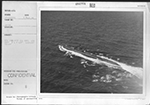 |
698k | Dragonet (SS-293) underway during her trials off the coast of New London CT., 6 September 1944, one month before sailing for the war zone. | US National Archives photo # 80-G-282701 from NARA, College Park, Maryland, courtesy of Sean Hert. | |
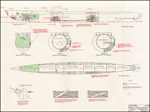 |
333k | On 15 December 1944, during her first war patrol, Dragonet (SS-293) holed and flooded her forward torpedo room as a result of striking an uncharted reef while running submerged off the Kuril Islands, and sank to the bottom in about 90 feet of water. Dragonet was able to surface only after expelling the water from the torpedo room with salvage air, and she made the run back to base, through heavy weather, by continuing to maintain an air bubble in the damaged compartment. Although this case cannot be said to have resulted directly from enemy action, it has been included in this collection of war damage experiences to illustrate the problem of a submarine having one end compartment flooded while submerged. It is considered quite possible that other and less fortunate U.S. submarines during World War II may have received damage from enemy action, mine, ramming or grounding, which resulted in the flooding of an end compartment, and that the loss of these vessels may have been caused thereby. This report is based on the information contained in the references and on an informal interview with the then Commanding Officer. The Photographs were furnished by Navy Yard, Mare Island. The PLATE was prepared by this Bureau from data contained in the enclosures to reference (c). |
Photo & text courtesy of ibiblio.org. | |
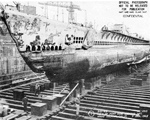 |
345k | Port side general view of the Dragonet (SS-293) in dry-dock looking aft showing damaged areas from grounding off the Kuril Islands on 15 December 1944. The boat was running submerged when it struck an uncharted reef. | Source: Navy Department Library: Submarine War Damage Report No. 58; Depth Charge, Bomb, Mine Torpedo and Gunfire Damage, Including Losses in Action via Mike Green. | |
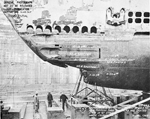 |
348k | Port side bow view of the Dragonet (SS-293) in dry-dock showing damage to torpedo tube shutters and fairing structure. | Source: Navy Department Library: Submarine War Damage Report No. 58; Depth Charge, Bomb, Mine Torpedo and Gunfire Damage, Including Losses in Action via Mike Green. | |
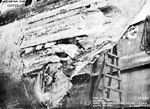 |
363k | Starboard side bow view of the Dragonet (SS-293) in dry-dock showing damage to torpedo tube shutters and fairing structure. Surprisingly, there was no misalignment of the torpedo tubes. | Source: Navy Department Library: Submarine War Damage Report No. 58; Depth Charge, Bomb, Mine Torpedo and Gunfire Damage, Including Losses in Action via Mike Green. | |
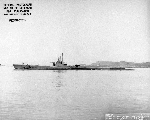 |
189k | Broadside view of Dragonet (SS-293), off Mare Island on 9 March 1945. Dragonet was in overhaul at the yard from 4 January until 26 March 1945. | USN photo # 1719-45, courtesy of Darryl L. Baker. | |
7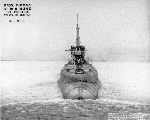 |
208k | Stern view of Dragonet (SS-293), departing Mare Island on 9 March 1945. | USN photo # 1722-45, courtesy of Darryl L. Baker. | |
 |
19k | Dragonet (SS-293), port view underway off Mare Island, sometime between 4 January until 26 March 1945. | Courtesy of subnet.com | |
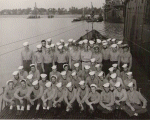 |
58k | Crew of the Dragonet (SS-293) on the deck of the boat as we were tied up to the Proteus (AS-19) in June, 1945, just before we left on on the 3rd patrol. | USN photo courtesy of Bill Pressnell. | |
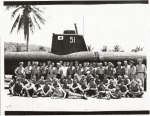 |
64k | Crew of the Dragonet (SS-293) in front of a JAP 2 man (suicide) sub that beached on Guam. Picture was taken at Camp Dealy rest camp in June 1945. XO J.A. Henry is on the left end of the back row. Bill Pressnell is in left front on the ground. | USN photo courtesy of Bill Pressnell. | |
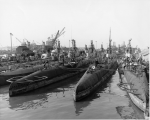 |
461k | 6 December 1945 photo appeared in the 14 December 1945 issue of the Mare Island newspaper lists the following subs present at the dockyard: Unknown, Dragonet (SS-293), Guavina (SS-362), Sunfish (SS-281), Sargo (SS-188), Spearfish (SS-190), Saury (SS-189). First two ships in second row appear to be: Bashaw (SS-241) and Mingo (SS-261). The Tiru (SS-416) is on the building ways on the left above the subs and surrounding by staging and cranes. It is interesting to note that the boats have started the mothballing process, as evidenced by the preservative cocoons around the deck guns. |
USN photo courtesy of Darryl L. Baker. Partial text courtesy of David Johnston |
|
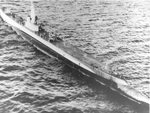 |
946k | Dragonet (SS-293), port view underway, date and location unknown. | U.S. Navy photo, courtesy of ussubvetsofworldwarii web site. | |
 | 137k | Reserve fleet at Mare Island, circa January 1946. There are 52 submarines and 4 Sub Tenders in this photo. This photo is a Berthing list identifying the ships in the picture. | Photo commentating 50 years, U. S. Submarine Veterans of WW II 1996 calendar, courtesy of Darryl L. Baker. | |
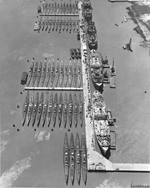 | 453k | Photo of the Reserve fleet at Mare Island, circa January 1946. There are 52 submarines and 4 Sub Tenders in this photo. Whether coincidental or on purpose, the number of boats in the photo is the same as that which were lost in WW II. From back to front and left to right, first group of 12 boats: Sand Lance (SS-381) Tunny (SS-282) Aspro (SS-309) Lionfish (SS-298) Guvania (SS-362) Sunfish (SS-281) Macabi (SS-375) Gurnard (SS-254) Pampanito (SS-383) Mingo (SS-261) Guitarro (SS-363) Bashaw (SS-241) From back to front and left to right, second group of 12 boats: Sealion (SS-315) Hammerhead (SS-364) Bream (SS-243) Seahorse (SS-304) Tinosa (SS-283) Pintado (SS-387) Mapiro (SS-376) Pipefish (SS-388) Moray (SS-300) Batfish (SS-310) Hackleback (SS-295) Bluegill (SS-242) From back to front and left to right, third group of 12 boats: Hawkbill (SS-366) Menhaden (SS-377) Perch (SS-313) Loggerhead (SS-374) Barbero (SS-317) Baya (SS-318) Hardhead (SS-365) Spadefish (SS-411) Springer (SS-414) Devilfish (SS-292) Kraken (SS-370) Dragonet (SS-293) From back to front and left to right, fourth group of 12 boats: Lamprey (SS-372) Piranha (SS-389) Manta (SS-299) Pargo (SS-264) Rancador (SS-301) Archerfish (SS-311) Mero (SS-378) Sawfish (SS-276) Spot (SS-413) Lizardfish (SS-373) Jallao (SS-368) Icefish (SS-367) From back to front and left to right, last group of 4 boats: Steelhead (SS-280) Puffer (SS-268) Stickleback (SS-415) Trepang (SS-412) From back to front, Submarine Tenders group of 4 ships: Pelias (AS-14) Aegir (AS-23) Euryale (AS-22) Griffin (AS-13). | Photo commemorating 50 years, U. S. Submarine Veterans of WW II 1996 calendar, courtesy of Darryl L. Baker. | |
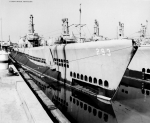 |
248k | Dragonet (SS-293) in the Mare Island Group Reserve Fleet on 13 October 1948. Spadefish (SS-411) is the third submarine outboard of Dragonet. | USN photo # 1913-10-48, courtesy of Darryl L. Baker. | |
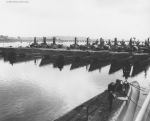 |
173k | Submarines aft of unidentified submarine in foreground at Mare Island Reserve Fleet on 28 September 1950 are: Left to right: Dragonet (SS-293), Menhaden (SS-377), Mapiro (SS-376), Seahorse (SS-304), Sand Lance (SS-381), Batfish (SS-310), Capitaine (SS-336), Pipefish (SS-388) and Manta (SS-299). |
USN photo # 6988-9-50, courtesy of Darryl L. Baker. | |
| Back To The Main Photo Index | Back To the Submarine Index |
|
Problems and site related matters, E-mail Webmaster |
|
This page was created and maintained by Michael Mohl All Pages © 1996 - 2023, NavSource History All rights reserved. |